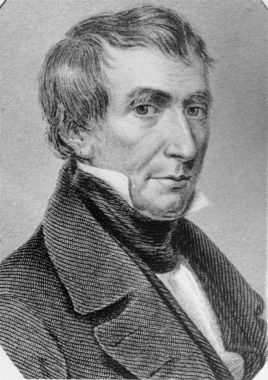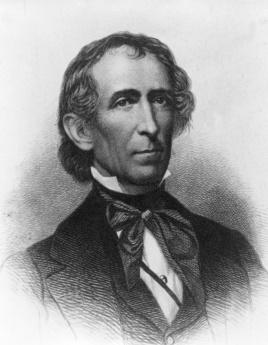From VOA Learning English, welcome to The Making of a Nation, our weekly program of American history for people learning American English. I'm Steve Ember.
In November of 1840, the American people elected William Henry Harrison as their ninth president. Harrison was a retired general and a well-known Indian fighter. Many people considered him a hero for his victory over Native Americans at the Battle of Tippecanoe in 1811.
Americans elected John Tyler as Harrison's vice president. The two men ran on the campaign slogan "Tippecanoe and Tyler Too!"

William Henry Harrison, is shown in this undated portrait, served the shortest presidential term in American history. Harrison was in office only 31 days before he died of pneumonia April 4, 1841. (AP Photo)
Harrison was the first president from the Whig party. Some Whig leaders, including Senators Henry Clay and Daniel Webster, believed they could control the newly elected president.
Harrison asked Daniel Webster to edit the speech he planned to give after the swearing-in ceremonies. Webster removed some material from the inaugural speech and suggested other changes.
The inauguration took place on March 4, 1841. It was the coldest inaugural day in the nation's history. Harrison spoke on the front steps of the Capitol building. He gave the longest inaugural address of any president. It lasted almost two hours.
But Harrison did not wear a winter overcoat or hat. He got sick, probably from standing so long outside in the cold. Rest was his best treatment. But the new president was so busy, he had little time to rest.
Harrison Dies After One Month as President
Harrison's health grew worse. Late in March 1841, he developed pneumonia. Doctors did everything they could to cure him. But nothing seemed to help. On April 4, exactly one month after he became president, William Henry Harrison died.
Vice President John Tyler was then at his home in Williamsburg, Virginia. Daniel Webster, the new secretary of state, sent his son on horseback to tell Tyler of the president's death.
The vice president was shocked. He had not even known that Harrison was sick. Two hours after he received the news, Tyler was on his way to Washington.
There was some question about Tyler's official duties. Harrison's death marked the first time that a president had died in office. No one was sure what the Constitution meant when it said that the powers of a deceased president should go to the vice president.
Eventually, Tyler, Webster and other cabinet members decided that Tyler should be president and serve until the next election.
"That was a very controversial claim. Because people said no, he's not the president, he's an acting president. He's just temporarily filling the office, but he's not president."
Historian Michael Holt taught at the University of Virginia. He says although not everyone supported John Tyler's claim, he set an important example. He showed how power could transfer peacefully to the vice president after a U.S. president died in office.
John Tyler Becomes President
Tyler was sworn-in as the nation's 10th president on April 6, 1841. He was 51 years old. No other man had become president at such an early age.
Tyler was a slave-holding southerner. He was born and grew up in the same part of Virginia as William Henry Harrison. His father was a wealthy landowner and judge who had been a friend of Thomas Jefferson.
Tyler completed studies at the College of William and Mary, and became a lawyer. He entered politics and served in the Virginia state legislature. Then he was elected a member of Congress and, later, governor of Virginia. He also served as a member of the United States Senate.
Tyler believed strongly in the rights of the states. As a congressman and a senator, he had voted against every attempt to give more power to the federal government. In fact, historian Michael Holt says that in many ways, Tyler was more like a member of the Democrats -- the opposing party at the time.
"He favored the typical position of Democrats on what we could call domestic policy, which is ‘that government is best which governs least.' So the less federal domestic policy you have trying to generate economic growth or improve society or whatever, the better."
In comparison, many Whig Party members firmly supported the ideas of a national bank, a protective tax on imports, and federal spending to improve transportation in the states. Tyler was just as firmly against these ideas.
At the same time, many Democrats did not like the president either.
"Most Democrats regarded him as a traitor who had jumped from the Jackson party and joined the Whigs, however temporarily."

John Tyler, the 10th president of the United States, 1841-1845, is shown in this undated illustration. (AP Photo)
Michael Holt says even Tyler's appearance made him seem difficult and unpleasant.
"You look at this guy and he's sort of aesthetically thin, and with sunken cheeks, and a long pointed nose. He just looks like he's unhappy with the world."
Support for National Bank Costs Tyler Support
President Tyler quickly became even more unpopular over the issue of a new national bank. He wanted to establish such a bank in the nation's capital, Washington, DC. The national bank could open offices in a state, but only if the state approved.
Tyler's proposal was not the kind of bank most Whigs in Congress supported. They wanted no limits of any kind on the power of a national bank to open offices anywhere in the country.
Whigs in Congress suggested a compromise: bank offices would be permitted in any state where the state legislature did not immediately refuse permission.
But President Tyler vetoed the compromise. He sent the bank bill back to Congress.
The congressmen wrote another bill. They said it was exactly what the president wanted. But the president did not agree. He said the states must have the right to approve or reject bank offices.
He said this second bill would also be vetoed unless changes were made in it. The changes were not made. And Tyler did as he said he would do. He vetoed it.
The decision created a crisis in the cabinet. All the president's advisors but one — Daniel Webster — resigned.
Michael Holt says that, several days later, most cabinet members and a large group of other Whig congressmen voted to expel Tyler from the party.
"And they read this paper saying he's no Whig, don't blame us for all his vetoes."
Harrison appointed a new cabinet of Whigs he hoped would be more friendly to him. But after a while, they too resigned. Michael Holt says Tyler made more changes in his cabinet than any other U.S. president.
Tyler Faces Other Crises
President Tyler struggled with his party over other issues. One was about import taxes.
Two years into Tyler's presidency, the government found itself short of money. It was spending more than it had. Congress decided that import taxes should be raised, some even higher than 20 percent.
But President Tyler vetoed the bill. He said it was wrong to raise the tax so high and, at the same time, continue to give the states money from land sales. He said the federal government itself needed the land-sale money.
Michael Holt says once again, the Whigs were angry. Their party controlled both houses of Congress and the White House, but they could not reach their goals.
"The Whigs were elected with this agenda that they wanted Congress to pass, that they had promised would rescue the country from a very serious depression. And this included a new national bank, higher tariffs, distribution of federal revenues from public land sales."
President Tyler, he adds, frustrated the entire Whig legislative program.
It was clear the Whigs would not nominate him for the next election. So Tyler turned his attention to the Democrats. He hoped they would ask him to be their presidential candidate in 1844.
Tyler Seeks Support from Democrats
Tyler began appointing Democratic advisors to his cabinet. And he gave his support to one of the Democrats' causes: making Texas a state in the Union.
Texas was an independent nation at the time. Some Americans wanted to bring Texas into the United States to further expand the country. But others were afraid that the territory would permit slavery. They wanted to keep an equal balance between slave-holding and non-slave-holding states.
President Tyler had the opposite fear. Michael Holt explains that Tyler was afraid that Texas would remain an independent republic and abolish slavery there.
"He and other southerners thought that was a terrible idea. But he also believed that this is what's going to put him in the history books. He's going to be responsible for adding this enormous republic of Texas -- although it wasn't quite as big as what they claimed -- to the United States."
The election of 1844 and the question of Texas statehood will be our story next week.
I'm Steve Ember, inviting you to join us next time for The Making of a Nation - American history from VOA Learning English.












